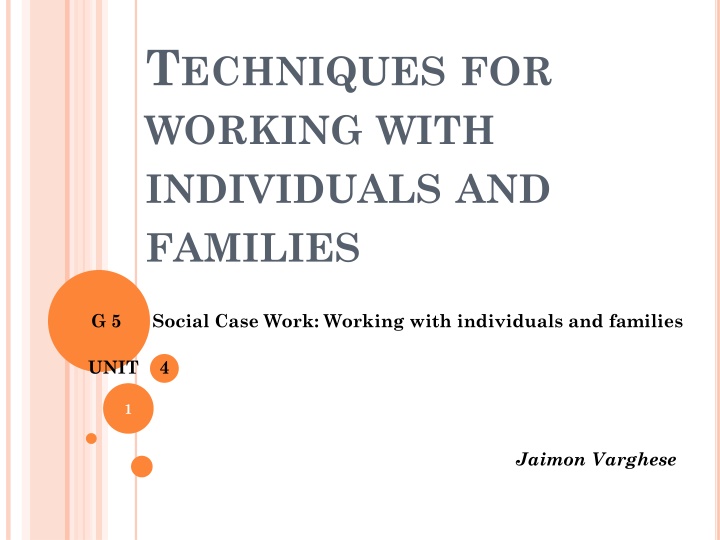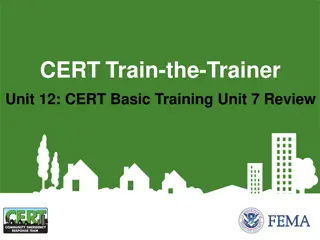
Social Work Techniques: Supporting Individuals and Families
Learn about essential social work techniques for working with individuals and families, including explorative and supportive approaches. Explore methods to provide assurance, allay overpowering feelings, and enhance self-confidence to facilitate positive outcomes.
Download Presentation

Please find below an Image/Link to download the presentation.
The content on the website is provided AS IS for your information and personal use only. It may not be sold, licensed, or shared on other websites without obtaining consent from the author. If you encounter any issues during the download, it is possible that the publisher has removed the file from their server.
You are allowed to download the files provided on this website for personal or commercial use, subject to the condition that they are used lawfully. All files are the property of their respective owners.
The content on the website is provided AS IS for your information and personal use only. It may not be sold, licensed, or shared on other websites without obtaining consent from the author.
E N D
Presentation Transcript
TECHNIQUES FOR WORKING WITH INDIVIDUALS AND FAMILIES G 5 Social Case Work: Working with individuals and families UNIT 4 1 Jaimon Varghese
INTRODUCTION Casework Techniques are the procedures of helping the client. They are the wherewithal through which the client gets the experience of being helped. The client may not perceive the procedures as specific units or characteristics of his/her contact with the social worker, but (s)he will generally experience the fact of being helped. 2
TECHNIQUES Explorative techniques Supportive techniques Techniques of enhancing resources 3
SUPPORTIVE TECHNIQUES 1. Assurance 2. Allaying feelings that are overpowering 3. Accrediting and building of Self- Confidence 4. Encouragement and Reassurance 5. Being With the Client 6. Action- Oriented Support 7. Advocacy 4
# ASSURANCE The client needs assurance regarding the authenticity of his/her feelings and that s(he) will not be judged, or ostracized for his/her feelings The client has to be helped to understand the difference between feelings and doing. One may feel murderously angry at another person but does not have feel guilty as long as one does not commit murder or do any other wrong thing that causes harm to the person against whom s(he) has the angry feelings. Feelings of any kind are neither wrong nor blameworthy, but certain acts carried out under the force of feelings can be unlawful and wrong because of the harm it causes to others. 5
This is what is a social worker is expected to say: I can understand your feelings of anger. It is human and natural to have these feelings in such circumstances 6
# ALLAYINGFEELINGSTHATAREOVERPOWERING Stressful events can provoke strong feelings in an individual which affect his/her capacity for thinking and acting appropriately. Sometimes the feelings become so strong, people become toys in their own hands. People cant see out of that When the mind is filled with disturbing emotions, the individual tend to withdraw into himself /herself and brood over the matters causing stress. Brooding causes the stress to expand and occupy full space of the mental screen, shutting out possibilities of rational thinking. 7
When the social worker intervenes,(s)he is able to arrest the client's mental process of withdrawing and brooding by helping the person to verbalise, to perceive the situation realistically, and by opening to his view, avenues for new thinking. 8
# ACCREDITINGAND BUILDINGOF SELF- CONFIDENCE It has to be remembered that the social worker cannot take over the client's problem, however helpless the client may be. All techniques should be directed towards making the client an active participant in problem solving, and for that, the client needs to develop self-confidence. 9
The Social worker should help the client to understand himself. His beliefs should be made stronger by the Social Case Worker. The strength , capabilities, abilities, the client possess, the CW should make them aware of it to build their self-confidence. 10
# ENCOURAGEMENTAND REASSURANCE Encouragement and reassurance need to be used to clients' advantage in casework. It is a common experience of social workers that clients are generally reluctant to do unfamiliar things without strong encouragement, albeit doing such things is necessary to improve the situation. 11
While using encouragement and reassurance, the social worker has to ensure that the situations are suitable for the exercise of these techniques. Encouraging a client to do things for which (s)he does not have the ability, or reassuring a client about the success of an activity (s)he is going to undertake which does not warrant certainty of success, is undesirable. 12
# BEINGWITHTHECLIENT Almost all clients need emotional support in order that they may feel comfortable with the social worker, the agency and themselves to be able to use help to handle their difficulties. The CW should develop a feeling in the mind of the client that s(he) is always there for them. It develops a mental support to the client. 13
When the client lacks self-confidence or is weighed down with excessive anxiety regarding carrying out a necessary action, the social worker's presence will serve as a support. There can be two types of support- Action- oriented support and Emotional Support 14
# ADVOCACY Advocacy involves making a request to a third person in support and on behalf of the client. There are people among the public who acknowledge the personalised service content of social work and give credence to the reports and requests of social workers. 15
TECHNIQUESFORENHANCINGRESOURCES Providing or Procuring Material Help Change of Physical Environment Enhancing Information and Knowledge 16
# PROVIDINGOR PROCURING MATERIAL HELP Apart from the support' provided through various techniques, some clients will need material help, that is, help in the form of money or materials. Some agencies have provision to provide material help in a small way. For some other clients, money or materials were procured from charitable trusts and organisations. 17
# CHANGEOFPHYSICALENVIRONMENT Another aspect is the change of physical environment which will be necessary for some clients for better functioning. Some of the children who were referred to the community centres for poor academic performance were children who had no facilities at home for quiet study. 18
Their dwelling places were often overcrowded with too many persons living in a small area of space and there was no nook or corner where they could sit and read. Arranging a place for them which they could use for a few hours every day for study was helpful. 19
#ENHANCING INFORMATIONAND KNOWLEDGE Among the resources required for human functioning is the non-material resource of information and knowledge, the lack of which can create problems or aggravate the problems that are already present. Sometimes, lack of information may be further confounded by the presence of misinformation or superstition. There are many wrong ideas about the causation and treatment of certain diseases. 20
Imparting knowledge, like any other casework technique is used according to the needs of the situation and the client 21
EXPLORATIVETECHNIQUES (COUNSELLING TECHNIQUES) Reflective discussion 1. 2. Advice 3. Motivation 4. Clarification 5. Correcting perception 6. Modelling 7. Anticipatory Guidance 8. Role Playing 22
Reality orientation 9. 10. Removing Guilt feelings / Using Guilt Feelings constructively 11. Partialization 12. Interpretation 13. Universalization 14. Setting Limits 15. Confrontation 23
16. Reaching Out 17. Renewing Family Links 18. Improving communication patterns 19. Changing attitude 24
# REFLECTIVEDISCUSSION Reflective discussion is discussion between the social worker and the client based upon the client's deep thinking on the different areas of his/her life that have a bearing upon his/her problem. By means of appropriate questions, empathetic remarks, and statements linking the various elements of the problem, the social worker should be able to draw out the client's capacity for thinking and to help him/her to reflect upon the different aspects of the situation. Reflective discussion as a multiple technique may span a part or the whole of one or more interviews. 25
# ADVICE It is very important techniques of Social Case Work. Advise the client to think differently; think about the problems of others caused by him/her But in casework, advice should be based on the situation of the client. Advice should be good suggestion, i.e., based on the complete knowledge about the problem. It should be useful to the client and practicable and relevant. 26
# MOTIVATION Closely connected with advice is 'motivation', (a multiple technique). One who advises, guides and finally persuades a man is called a motivator. In casework, motivation refers to influencing the client to take a course of action that is considered good for him and his family) or that is necessary for solving the problem he faces. 27
# CLARIFICATION Clarification means conceptually disentangling the various factors of a situation, to render it more comprehensible to the client. It would involve explicating one or more elements of the situation that are not perceived correctly by the client. 28
# CORRECTINGPERCEPTION Correcting perception is also a technique in casework. Clarification often leads to the correction of the client's Perception At other times, new information or knowledge is required to change perception. When clients are emotionally upset they need to have their feelings clarified for them, so that, they may be able to perceive their own feelings correctly. 29
# MODELLING Clients do learn from what the social worker says and also from what (s)he does. Since the social worker converses purposefully and responsibly, some clients learn helpful and constructive ways of communication from their experience of the social workers pattern of communication. When the social worker presents a prototype of behaviour with the idea that, the client may learn new forms of speaking and doing, it is the modelling technique at work. 30
# ANTICIPATORY GUIDANCE Anticipatory guidance of clients by the social worker will, to some extent, dilute the fear and anxiety surrounding a future event. Mentally and verbally picturing a future situation in its entirety, is a good way of handling the anxiety that is currently provoked by thoughts about the event. It is also a good preparation for facing the event. 31
# ROLEPLAYING Anticipatory guidance becomes more explicit with the help of another technique, role playing. The future event is mentally brought forward to the present, and simulated by the social worker with himself or herself and the client assuming the roles of the people involved in the situation, including the role of the client. Role playing is a valuable technique as a teaching and learning device. Very often, in role playing, modelling and anticipatory guidance are implicit. 32
#REALITYORIENTATION When clients face problems and beat around the bush without being able to face reality, realityorientation is called for. It can be seen that reality orientation is to be used with clients whose ego-function of reality testing operates insufficiently. What the social worker tries to achieve is, to activate and strengthen this ego-function. 33
# REMOVINGGUILTFEELINGS Some clients have difficulty in handling the guilt feelings, whether they be warranted or unwarranted. Guilt feelings are unwarranted when they are unrealistic and without substantial reasons. Removing guilt-feelings was essential in all these cases before the clients could participate in the problem solving process. Guilt feelings should be used constructively 34
# PARTIALIZATION Partialization refers to breaking up the situation into its different problematic aspects and then focusing on the aspect which needs immediate attention. When there are many problematic aspects of equal importance, not all requiring urgent attention, partialisation will help to take up the area which is straightforward and which can be done without much difficulty, keeping in view the possibility that the client will have the satisfaction of attaining something. 35
# INTERPRETATION Interpretation means explanation. Interpretation may be given directly to the client, or to certain members of the clients family. For ex.- Keshav (15 years) was lagging behind in his studies. He was often compared unfavourably, both, with his older siblings and his classmates. His parents, besides complaining about Keshav's poor academic performance, had another worry that he was always seen playing with smaller boys.. 36
His wanting to play with smaller boys could be interpreted as the result of his inferiority feelings which he experienced in the company of his brighter classmates and siblings 37
#SETTINGTHELIMITS The concept of acceptance does not imply that every kind of behaviour has to be accepted or condoned. The client as an individual has to be accepted unconditionally, but his behaviour may be approved conditionally, and hence, the need for the technique of setting limits to certain types of behaviour. The setting of limits becomes necessary while dealing with children, adolescents and even adults with behaviour problems. 38
# UNIVERSALIZATION When clients tend to consider their problems as unique, and thereby, subject themselves to excessive anxiety or self-pity, it will be helpful to bring to their awareness the reality that there are many others facing the same problem. This is universalization. It is expected that by universalizing the problem, the anxiety may be reduced in intensity, and that, hope may be derived from the knowledge of persons who are coping better with the same problem. 39
# CONFRONTATION Confrontation means bringing the client face- to-face with the lapses in his/her own behaviour that have turned out to be harmful. The aberrations or lapses in behaviour referred to are those which are subsequent to his/her earlier commitment to a plan or decision in the presence of the social worker. 40
# REACHINGOUT 'Reaching out', for instance, refers to clients who really need help, but who for some reason or other do not ask for it or may even reject it in the initial stages when help is offered. When the social worker notices such persons in the precincts of his/her work, s(he) may have to reach out, or stretch out his/her hand in a friendly gesture to convey to them the message that (s)he would be of service. 41
# RENEWINGFAMILYLINKS Efforts at renewing family links may be made simultaneously along with reaching out to the children through persistent befriending. Institutionalisation, in some cases, means a disruption of family connections and/or the family's failure to keep in touch with the children. 42
It is thus another emotional injury that can be prevented, by taking steps to renew the family ties. Reaching out becomes meaningful when it sets in motion a three-way communication, between the social worker and the child, the social worker and the child's family and between the family and the child. 43
# CHANGINGATTITUDES Changing the attitudes is a complex multiple technique involving the use of other techniques. It must be borne in mind that it is not the social worker who changes the client's attitude: the change has to be generated by the client himself, within himself in which the social worker is the facilitator. 44
#IMPROVING COMMUNICATION PATTERNS Another multiple technique is that of improving communication patterns in the client's family. Very often family relationships are strained, because the members, instead of communicating with one another react to their own feelings aroused in the situational context. Thus, communication gets blocked without serving the purpose of sending and receiving information. 45
ROLESOF CASEWORKER Enabler: capacity building, training, education, instruction Facilitator: helping, liaison, lobbying, advocacy Resource mobiliser: linkage, networking, arrange finance, legal aid, family and community support Guide: counselling, guidance, suggestion, advise 46
THANK YOU 47




















